Freelance jobs are revolutionizing the way people work. More freedom, more income potential, and no boss breathing down your neck sounds like a dream, right?
But let’s be real. Freelancing isn’t just about working in pajamas while sipping coffee in a trendy café. It’s not a magical ticket to easy money, either. Some months will be amazing, others? You’ll wonder if you made the right choice.
Still, if you play your cards right, freelance jobs can be your gateway to financial independence and a flexible lifestyle. No more soul-sucking meetings. No more frustrating commutes. Just you, your skills, and work that actually pays what you’re worth.
So, how do you make it work? Let’s dive in.

Key Takeaways
- Freelancing is a business, not just a side gig – Success comes from treating it like a professional career, not just an occasional project.
- Specialization increases earning potential – The more niche your expertise, the easier it is to stand out and charge higher rates.
- Pricing should be based on value, not just time – Clients pay for the results you provide, not just the hours you work.
- Visibility attracts more clients – The more you market yourself online, the more job opportunities you’ll get.
- Repeat clients create stability – Long-term client relationships reduce the need to constantly hunt for new gigs.
What Are the Most Common Freelance Jobs?
Freelancing spans multiple industries, offering a variety of opportunities based on skills, demand, and earning potential.
Some fields are easier to break into, while others require technical expertise or industry experience.
Below are some of the most in-demand freelance jobs, along with key benefits and considerations.
Writing & Content Creation
Freelance writing is one of the most accessible and highly demanded skills in freelancing.
Writers create content for blogs, websites, social media, and businesses looking to improve their brand messaging and SEO rankings.
Common Writing Jobs:
- Blogging – Writing engaging articles for businesses and personal brands.
- Copywriting – Crafting persuasive marketing and sales copy.
- Ghostwriting – Writing books, articles, or speeches under someone else’s name.
- Technical Writing – Creating manuals, guides, and documentation for tech-related industries.
- Editing & Proofreading – Refining content before publication.
💡 Best for: Writers who enjoy storytelling, research, and content marketing.
Graphic & Web Design
With businesses shifting online, visual branding and website design are more crucial than ever.
Freelance designers create everything from logos to social media graphics, helping businesses establish their brand identity.
Common Design Jobs:
- Logo & Branding Design – Creating unique brand identities for businesses.
- Web Design & UI/UX – Designing user-friendly, visually appealing websites.
- Illustration & Digital Art – Custom artwork, book illustrations, and graphics.
- Social Media Graphics – Creating images for Instagram, Facebook, and LinkedIn.
💡 Best for: Creatives skilled in Photoshop, Illustrator, Figma, or Canva.
Programming & Web Development
Tech-related freelance jobs offer some of the highest-paying opportunities due to high demand.
Developers help businesses build and maintain digital platforms, apps, and automation tools.
Common Programming Jobs:
- Website Development – Building and maintaining business websites, blogs, and e-commerce platforms.
- Mobile App Development – Developing apps for iOS and Android.
- WordPress Development – Customizing themes and plugins for WordPress-based sites.
- AI & Automation Programming – Developing AI-powered tools and automated workflows.
💡 Best for: Freelancers with coding skills in JavaScript, Python, PHP, or React.
Marketing & SEO
Marketing professionals help businesses grow their online presence, attract customers, and improve brand engagement.
Freelancers in this category focus on increasing website traffic, running ad campaigns, and optimizing content for search engines.
Common Marketing & SEO Jobs:
- Social Media Management – Managing and growing business accounts on Instagram, Twitter, and Facebook.
- SEO & Content Marketing – Improving website rankings through keyword research and optimization.
- PPC Advertising – Running paid ad campaigns on Google, Facebook, and LinkedIn.
- Email Marketing – Writing and automating email campaigns to drive engagement and sales.
💡 Best for: Digital marketers who understand analytics, customer psychology, and engagement strategies.
Virtual Assistance & Admin Work
Many businesses outsource administrative tasks to virtual assistants, making it a great entry point into freelancing.
These roles require organization, communication skills, and attention to detail.
Common Virtual Assistance Jobs:
- Data Entry – Entering and organizing information.
- Customer Support – Managing emails, chats, and support tickets.
- Calendar & Email Management – Scheduling meetings and organizing inboxes.
- E-commerce Support – Managing product listings, orders, and customer inquiries.
💡 Best for: Highly organized individuals comfortable with routine tasks and administrative work.
Consulting & Coaching
Freelancers with specialized knowledge or industry experience can offer consulting services, providing expertise in areas like business strategy, finance, and personal development.
Common Consulting Jobs:
- Business Consulting – Helping businesses optimize operations and strategy.
- Financial Planning – Assisting individuals and companies with budgeting and investments.
- Career Coaching – Guiding professionals on job searches and career growth.
- Health & Fitness Coaching – Developing fitness plans and wellness strategies.
💡 Best for: Experienced professionals looking to monetize their knowledge through advisory roles and mentorship.
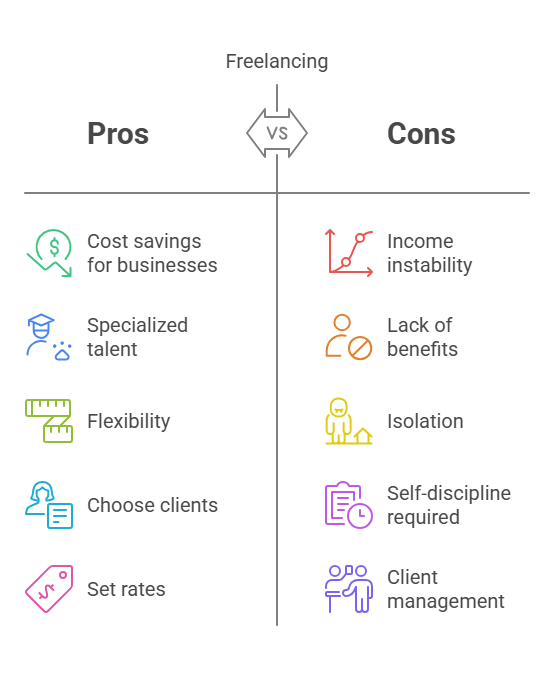
How to Choose the Right Freelance Niche
Not all freelance jobs are created equal. Some fields offer high earning potential, while others have lower barriers to entry but higher competition.
Choosing the right niche is crucial because it determines how much you can charge, how easy it is to get clients, and how sustainable your freelance career will be.
A well-chosen niche helps you:
- Stand out in a crowded market by offering specialized expertise.
- Attract higher-paying clients who need your specific skill set.
- Position yourself as an authority, making it easier to win projects.
How to Pick the Right Niche
Choosing a niche isn’t just about picking what’s trending, it should align with your skills, interests, and market demand. Here’s a framework to help you decide:
1. Identify Your Skills and Strengths
- What are you already good at? (Writing, coding, design, marketing, etc.)
- Do you have any formal training, certifications, or experience in a particular field?
- Are there industries you understand well (e.g., finance, health, SaaS, real estate)?
2. Research Market Demand
Some niches are more profitable and in demand than others. A good niche should have a strong client base willing to pay for expertise.
Ways to check demand:
- Look at freelance job boards (Upwork, Fiverr, PeoplePerHour) to see which skills are in demand.
- Check LinkedIn job postings for freelance roles in different industries.
- Use Google Trends or keyword research tools to see search volume for services.
3. Consider the Competition
- High-demand fields also attract high competition.
- Specializing in a sub-niche can help you avoid competing with generalists.
- Example: Instead of being a general “SEO writer,” position yourself as an SEO writer for e-commerce brands.

Freelance Jobs: Hottest Niches Right Now
If you’re unsure where to start, consider these high-growth freelance niches:
1. Tech & AI Development
- AI automation & chatbot development.
- API integrations and SaaS development.
- High demand due to business automation trends.
2. E-commerce Support
- Shopify and WooCommerce website management.
- Product listing optimization and marketing.
- Online stores need constant content, updates, and advertising.
3. Financial & Business Consulting
- Business strategy, budgeting, and tax consulting.
- Freelance CFO services.
- Growing demand from small businesses and startups.
4. Health & Wellness Writing
- Nutrition, fitness, and mental health content.
- High-paying niche with a large audience seeking expert advice.
5. Social Media & Branding
- Content creation for Instagram, TikTok, and LinkedIn.
- Personal branding services for influencers and executives.
- Brands need consistent content to stay relevant online.
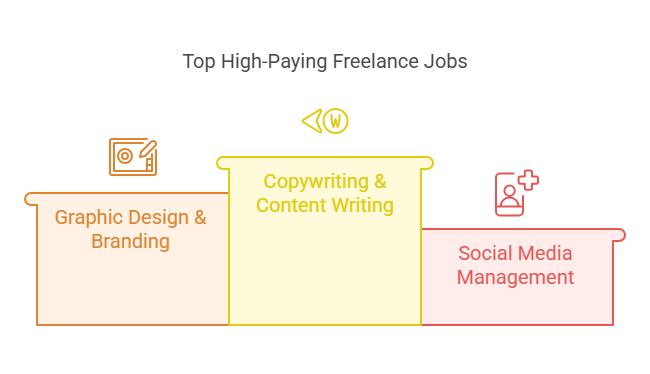
Freelance Jobs: Generalist vs. Specialist, Which is Better?
Many freelancers start as generalists, taking on various projects. However, specialists often earn more and face less competition.
Approach | Generalist | Specialist |
Description | Offers a broad range of services | Focuses on a single industry or skill set |
Pros | More job opportunities | Higher pay, less competition |
Cons | Harder to stand out | Limited job options in smaller markets |
Example | Writes blog posts for any industry | Writes SEO content for health & wellness brands |
💡 Pro Tip: If you’re starting out, it’s okay to experiment with different niches, but over time, narrowing your focus will make client acquisition easier.
Choosing the right niche sets the foundation for a successful freelance career. Once you know what you want to specialize in, the next step is pricing your services correctly to maximize earnings. Check out our Virtual Assistant Jobs Guide.
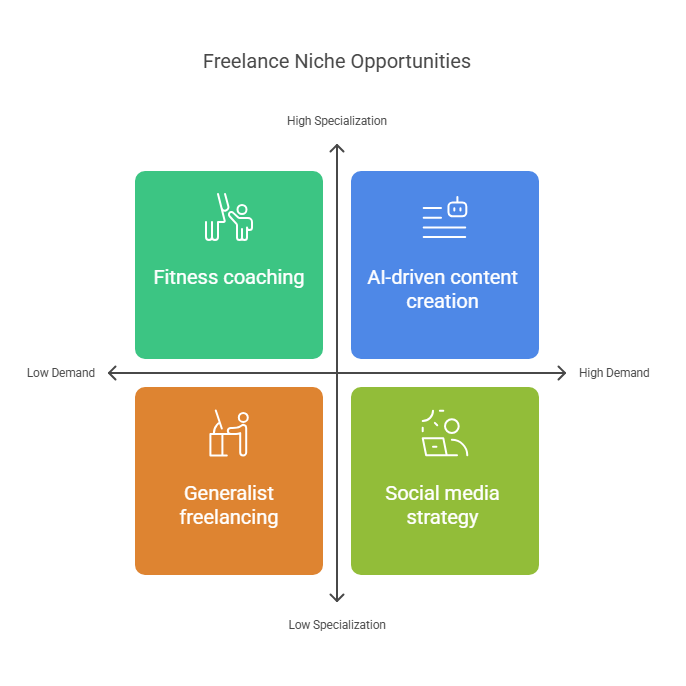
Freelance Jobs: How to Set Your Freelance Rates
One of the biggest challenges freelancers face is determining how much to charge. Set your rates too low, and you’ll struggle to make a sustainable income.
Price yourself too high without the right positioning, and potential clients may look elsewhere. Finding the right balance is key to building a profitable freelance career.
How Do You Price Yourself Right?
1. Research Industry Rates
Before setting your prices, it’s important to understand what freelancers in your niche are charging.
- Check freelance job boards (Upwork, Fiverr, PeoplePerHour) for price comparisons.
- Browse LinkedIn job postings to see salary ranges for similar roles.
- Use websites like Glassdoor or PayScale to research average freelance rates.
💡 Pro Tip: Industry rates vary based on experience, location, and demand. High-demand niches (e.g., AI development, financial consulting) typically command higher fees than general freelance work.
2. Consider Your Experience Level
Your pricing should reflect your expertise. Here’s a general guide:
Experience Level | Typical Rate | Example Niches |
Beginner | $15–$30/hour | Blog writing, admin work, social media management |
Intermediate | $30–$75/hour | SEO writing, web design, email marketing |
Expert | $75–$200+/hour | Copywriting, consulting, software development |
💡 Pro Tip: If you’re new to freelancing, start at competitive entry-level rates and gradually increase them as you build a strong portfolio and client base.
3. Charge for Results, Not Just Time
Freelancers who charge based on value rather than hours often earn more. Instead of billing per hour, consider project-based pricing or retainer contracts.
- Hourly Pricing: Best for short-term or ongoing support roles.
- Project-Based Pricing: Best for one-time deliverables (e.g., writing a website’s entire content).
- Retainers: Best for long-term clients who need ongoing work (e.g., monthly SEO services).
💡 Example: Instead of charging $30/hour for SEO services, charge $1,000 for an SEO strategy package that delivers measurable results.
4. Offer Packages and Upsells
Many freelancers maximize earnings by bundling services instead of offering them individually.
- Example:
A freelance social media manager could offer: - Basic Package – 10 posts per month ($500)
Growth Package – 10 posts + engagement strategy ($1,000) - Premium Package – Full social media management ($2,500)
💡 Pro Tip: Offering tiered pricing allows clients to choose a service level based on their budget while increasing your earning potential.
When and How to Raise Your Rates
Freelancers should regularly reassess their rates as they gain experience and improve their skills. Signs that it’s time to increase your rates include:
- You have more demand than you can handle.
- You consistently deliver high-value results for clients.
- Your experience and portfolio justify premium pricing.
- You’re attracting clients who are willing to pay more.
💡 Pro Tip: When raising rates, offer existing clients a transition period and focus on attracting higher-paying clients.
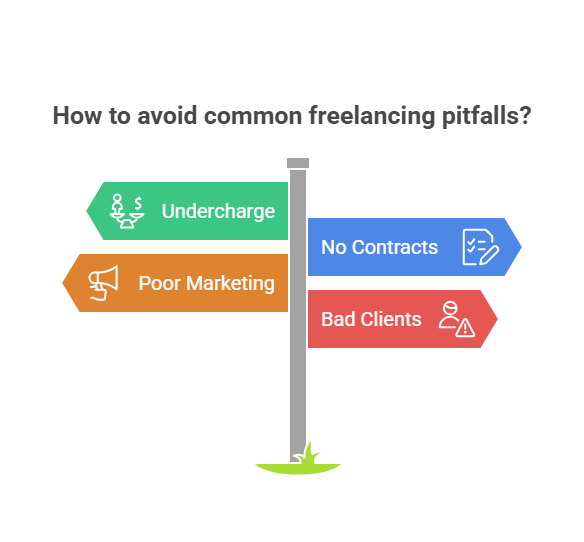
Freelance Jobs: How to Find and Keep Freelance Clients
Finding freelance clients is one of the most challenging aspects of freelancing, especially for beginners.
The key to success is being proactive, building visibility, and developing strong relationships that lead to repeat business.
Best Ways to Land Clients
1. Use Freelance Platforms
Freelance marketplaces are great places to start because they connect businesses with freelancers looking for work.
- Upwork – A global platform with opportunities for writers, designers, marketers, and developers.
- Fiverr – Best for selling packaged services at different price points.
- Toptal – A premium platform for top-tier professionals in design, writing, and development.
- PeoplePerHour – Ideal for creative and tech-related freelance gigs.
💡 Pro Tip: Optimize your profile and service descriptions with relevant keywords to increase visibility.
2. Direct Outreach (Cold Pitching)
Instead of waiting for clients to come to you, reach out to businesses that might need your services.
- Identify companies lacking strong content, design, or marketing and offer your expertise.
- Send a personalized email introducing yourself and how you can add value.
- Avoid generic messages focus on how you can solve a specific pain point for the business.
💡 Example: If you’re a freelance email marketer, reach out to e-commerce brands struggling with customer retention and offer an email campaign strategy.
3. Leverage Social Media & Personal Branding
Freelancers who actively share their expertise online attract more clients.
- LinkedIn – Optimize your profile with relevant skills and post valuable industry insights.
- Twitter/X – Engage in conversations with industry professionals and businesses.
- Instagram & TikTok – Showcase your work visually if you’re in design, writing, or coaching.
- Facebook Groups & Reddit – Join communities where businesses look for freelancers.
💡 Pro Tip: Share client success stories, case studies, and industry tips to position yourself as an expert.
4. Build a Personal Website & Portfolio
A strong online presence helps establish credibility and makes it easier for potential clients to find you.
- Create a website that highlights your best work, services, and testimonials.
- Include case studies showing how your work improved a client’s business.
- Optimize for SEO by using relevant keywords related to your niche.
💡 Example: If you’re a freelance SEO writer, having a blog with SEO case studies demonstrates your expertise and attracts inbound leads.
5. Get Referrals & Network
Word-of-mouth referrals are one of the best ways to get high-paying, long-term clients.
- Ask satisfied clients for referrals or testimonials.
- Join networking groups, coworking spaces, and industry conferences.
- Build relationships with other freelancers who can refer work to you.
💡 Pro Tip: Offer a referral incentive (e.g., a discount or bonus) for existing clients who refer new clients to you.

Freelance Jobs: How to Keep Clients & Secure Long-Term Work
Finding clients is one thing keeping them is even more important. Building strong client relationships leads to consistent income and long-term growth.
1. Deliver High-Quality Work Consistently
- Meet or exceed client expectations on deadlines and quality.
- Follow client brand voice and guidelines closely.
- Go the extra mile suggest improvements they may not have thought of.
2. Communicate Professionally & Promptly
- Respond to client emails and messages within 24 hours.
- Provide regular updates on project progress.
- Be transparent about deadlines, revisions, and expectations.
3. Offer Retainer Packages
Instead of chasing new clients every month, offer ongoing services on a monthly basis.
💡 Example: A freelance social media manager can offer:
- Monthly content creation & scheduling ($1,500/month).
- Engagement & ad management ($2,500/month).
4. Upsell Additional Services
If a client hires you for one project, suggest complementary services that can further help their business.
💡 Example: A freelance website copywriter can offer additional SEO services, email marketing, or content strategy consulting.
Freelancing is not just about doing great work, it’s about marketing yourself, building relationships, and maintaining a strong online presence.
The most successful freelancers don’t just wait for opportunities; they create them.

FAQs About Freelance Jobs
1. Can I start freelancing with no experience?
Absolutely! Build a portfolio with sample projects, offer free or discounted work at first, and get testimonials.
2. What’s the best freelance job for beginners?
Writing, virtual assistance, and social media management have low barriers to entry and high demand.
3. How do I find my first freelance client?
Use freelance job platforms like Upwork and Fiverr, reach out to small businesses, and network online.
4. How do I set my freelance rates?
Research what others in your field charge, then price yourself competitively. Avoid hourly rates—charge based on project value.
5. What tools do freelancers need?
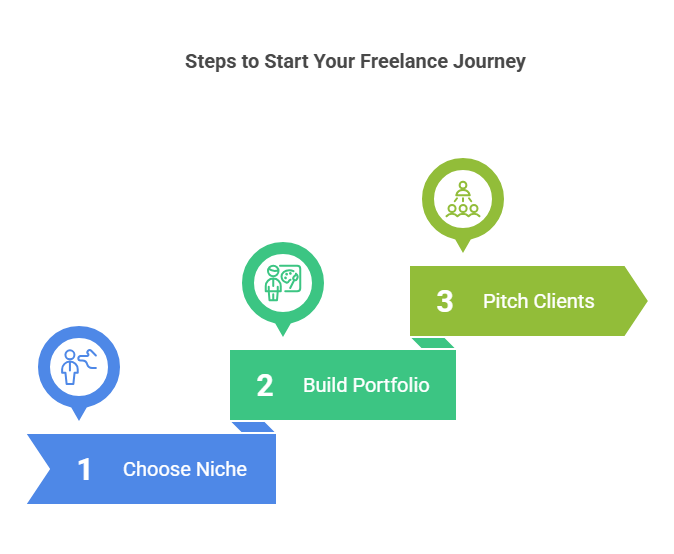
Final Thoughts: Your Future in Freelancing Starts Now
Freelancing isn’t just about doing what you love, it’s about building a system that brings work to you consistently. Many freelancers struggle because they treat freelancing as a series of one-off gigs instead of a business with long-term growth potential.
The most successful freelancers:
- Specialize in a profitable niche to stand out and charge higher rates.
- Set strategic pricing based on value rather than just hourly work.
- Proactively market themselves to attract clients instead of waiting for opportunities.
- Build relationships with clients to secure repeat business and long-term income.
The freelance economy continues to grow, offering countless opportunities for those who are willing to invest in their skills, create a strong personal brand, and approach freelancing like a business.
Freelance success isn’t about luck, it’s about strategy, persistence, and continuous learning. The opportunities are out there go after them.
Need help getting started? Drop a comment I’d love to hear what you’re working on! 🚀
Read our article about Remote Side Hustles.

2 Comments
Upwork vs Fiverr: Which Freelance Platform Wins in 2025? - Ismel Guerrero. · March 21, 2025 at 2:12 pm
[…] Next, check out our Freelance Jobs Guide. […]
Virtual Assistant Jobs: Get Started + What You Need to Know - Ismel Guerrero. · April 1, 2025 at 10:19 am
[…] Want to learn more here is our Freelance Jobs Guide. […]